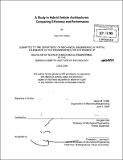| dc.contributor.advisor | Douglas Hart. | en_US |
| dc.contributor.author | Cotter, Gavin M | en_US |
| dc.contributor.other | Massachusetts Institute of Technology. Dept. of Mechanical Engineering. | en_US |
| dc.date.accessioned | 2010-04-28T16:57:23Z | |
| dc.date.available | 2010-04-28T16:57:23Z | |
| dc.date.issued | 2009 | en_US |
| dc.identifier.uri | http://hdl.handle.net/1721.1/54531 | |
| dc.description | Thesis (S.B.)--Massachusetts Institute of Technology, Dept. of Mechanical Engineering, 2009. | en_US |
| dc.description | "June 2009." Cataloged from PDF version of thesis. | en_US |
| dc.description | Includes bibliographical references (p. 19). | en_US |
| dc.description.abstract | This paper presents a comparison of performance and efficiencies for four vehicle power architectures; the internal combustion engine (ICE), the parallel hybrid (i.e. Toyota Prius), the serial hybrid (i.e. Chevrolet Volt), and the electric vehicle (i.e. Chevrolet EV-1). These four power schemes represent the most prominent power architecture options available to automotive designers and engineers today. Experimentation was preformed using a one-man power scooter, a five horsepower ICE, an alternator, three 12 volt batteries, and an electric motor. Data was collected using an accelerometer and timing device. The ICE architecture transmits power to the wheels from only from the engine, the parallel hybrid from both the ICE and the electric motor, the serial hybrid from only the electric motor with the ICE and alternator acting as a generator, and the electric vehicle (EV) from only the electric motor. Performance was quantified through top speed and acceleration numbers for each respective architecture. Each power scheme was modeled analytically to determine theoretical efficiencies and performance numbers. These theoretical numbers were then compared to experimental data for validation. Results from testing, as well as the factors represent the ratio of each attribute to the lowest value within that category (given the value 1), are shown in figure 1 below. ICE Series Parallel EV 25.6 14.1 25.6 14.1 2.5 3.7 3.7 3.7 32.4 62.7 54.3 74.0 1.8 1 1.8 1 1.5 1.5 1.5 1.0 1.9 1.7 2.3 Figure 1: Performance and Efficiency Values for Experimental Power Schemes. | en_US |
| dc.description.abstract | (cont.) These conclusions would allow, given desired output efficiencies or performance values, an automotive designer to determine which architecture(s) would best suit their needs. | en_US |
| dc.description.statementofresponsibility | by Gavin M. Cotter. | en_US |
| dc.format.extent | 20 p. | en_US |
| dc.language.iso | eng | en_US |
| dc.publisher | Massachusetts Institute of Technology | en_US |
| dc.rights | M.I.T. theses are protected by
copyright. They may be viewed from this source for any purpose, but
reproduction or distribution in any format is prohibited without written
permission. See provided URL for inquiries about permission. | en_US |
| dc.rights.uri | http://dspace.mit.edu/handle/1721.1/7582 | en_US |
| dc.subject | Mechanical Engineering. | en_US |
| dc.title | A study in hybrid vehicle architectures : comparing efficiency and performance | en_US |
| dc.type | Thesis | en_US |
| dc.description.degree | S.B. | en_US |
| dc.contributor.department | Massachusetts Institute of Technology. Department of Mechanical Engineering | |
| dc.identifier.oclc | 565894813 | en_US |
